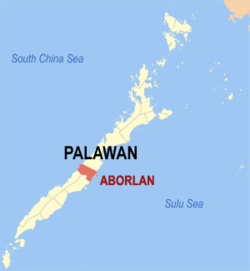Aborlan
Aborlan | |
|---|---|
| Municipality of Aborlan | |
 Map of Palawan with Aborlan highlighted | |
Location within the Philippines | |
| Coordinates: 9°26′19″N 118°32′53″E / 9.438639°N 118.548136°E | |
| Country | |
| Region | Mimaropa |
| Province | Palawan |
| District | 3rd district |
| Founded | June 28, 1949 |
| Barangays | 19 (see Barangays) |
| Government | |
| • Type | Sangguniang Bayan |
| • Mayor | Jamie M. Ortega |
| • Electorate | 29,443 voters (2022) |
| Area | |
| • Total | 807.33 km2 (311.71 sq mi) |
| Population (2020 census)[3] | |
| • Total | 38,736 |
| • Density | 48/km2 (120/sq mi) |
| Time zone | UTC+8 (PST) |
| ZIP code | 5302 |
| PSGC | |
| IDD : area code | +63 (0)48 |
| Income class | 1st municipal income class |
| Revenue (₱) | ₱ 369.7 million (2020) |
| Native languages | Aborlan Tagbanwa Palawano Tagalog |
Aborlan, officially the Municipality of Aborlan, is a 1st class municipality in the province of Palawan, Philippines. According to the 2020 census, it has a population of 38,736 people.[3]
It lies in a vast plain between the Sulu Sea and the mountains. It is located 69 kilometres (43 mi) south of Puerto Princesa City.
Aborlan was made into a regular municipality on June 28, 1949, by virtue of Executive Order No. 232.[4] In 1951, it lost the barrios of Berong and Alfonso XII when these were transferred to the then newly created town of Quezon.[5]
It is the only town in the province with an agricultural college, now called the Western Philippines University. It was founded in 1910.[4]
Barangays
Aborlan is politically subdivided into 19 barangays.
- Apo-Aporawan
- Apoc-apoc
- Aporawan
- Barake
- Cabigaan
- Gogognan
- Iraan
- Isaub
- Jose Rizal
- Mabini
- Magbabadil
- Plaridel
- Ramon Magsaysay
- Sagpangan
- San Juan
- Tagpait
- Tigman
- Poblacion
- Culandanum
Demographics
|
| |||||||||||||||||||||||||||||||||||||||||||||
| Source: Philippine Statistics Authority[6][7][8][9] | ||||||||||||||||||||||||||||||||||||||||||||||
In the 2020 census, the population of Aborlan was 38,736 people,[3] with a density of 48 inhabitants per square kilometre or 120 inhabitants per square mile.
References
- ^ Municipality of Aborlan | (DILG)
- ^ "Province: Palawan". PSGC Interactive. Quezon City, Philippines: Philippine Statistics Authority. Retrieved 12 November 2016.
- ^ a b c Census of Population (2020). "Mimaropa". Total Population by Province, City, Municipality and Barangay. Philippine Statistics Authority. Retrieved 8 July 2021.
- ^ a b "Aborlan" (PDF). Provincial Government of Palawan. Archived from the original (PDF) on 21 October 2013. Retrieved 22 November 2012.
{{cite web}}: Unknown parameter|deadurl=ignored (|url-status=suggested) (help) - ^ "An act to create the municipality of Quezon in the province of Palawan". LawPH.com. Archived from the original on 2012-07-10. Retrieved 2011-04-09.
{{cite web}}: Unknown parameter|dead-url=ignored (|url-status=suggested) (help) - ^ Census of Population (2015). "Region IV-B (Mimaropa)". Total Population by Province, City, Municipality and Barangay. Philippine Statistics Authority. Retrieved 20 June 2016.
- ^ Census of Population and Housing (2010). "Region IV-B (Mimaropa)" (PDF). Total Population by Province, City, Municipality and Barangay. National Statistics Office. Retrieved 29 June 2016.
- ^ Censuses of Population (1903–2007). "Region IV-B (Mimaropa)". Table 1. Population Enumerated in Various Censuses by Province/Highly Urbanized City: 1903 to 2007. National Statistics Office.
{{cite encyclopedia}}: CS1 maint: numeric names: authors list (link) - ^ "Province of Palawan". Municipality Population Data. Local Water Utilities Administration Research Division. Retrieved 17 December 2016.
External links
- Philippine Standard Geographic Code
- Philippine Census Information
- Local Governance Performance Management System
- Aborlan Palawan Photo Gallery

